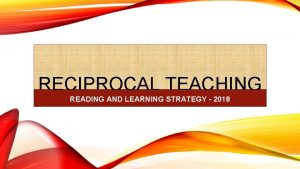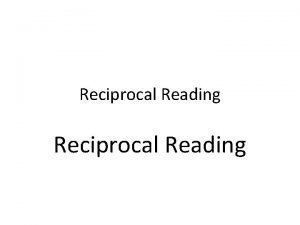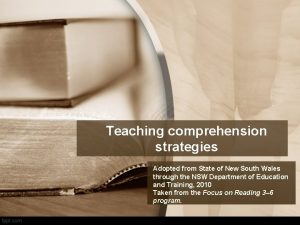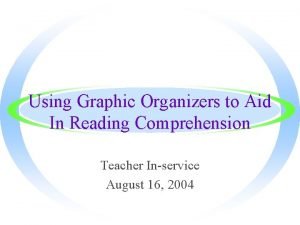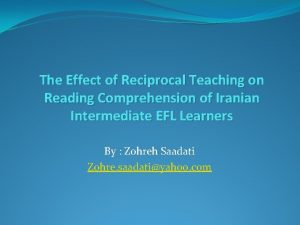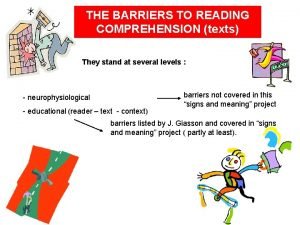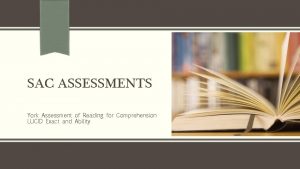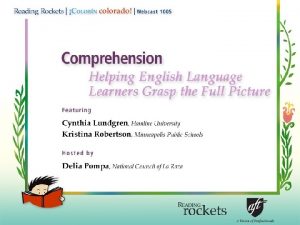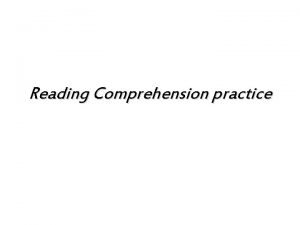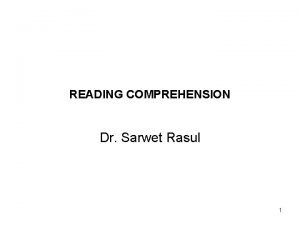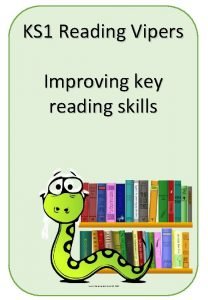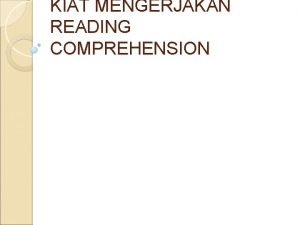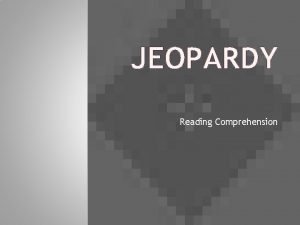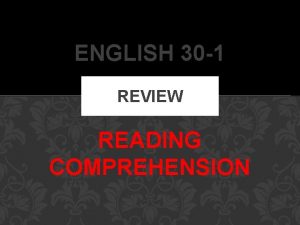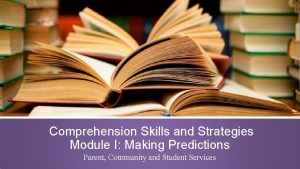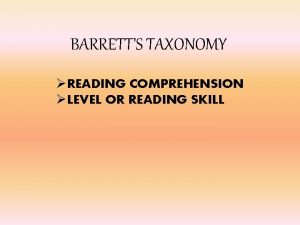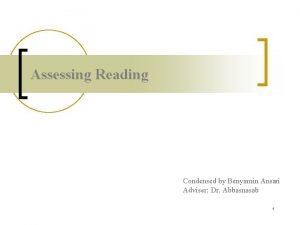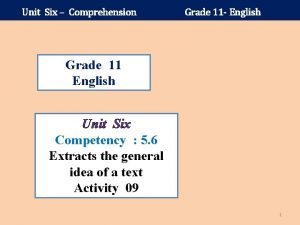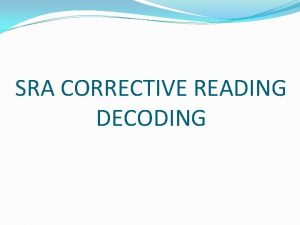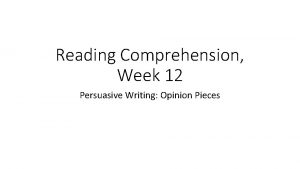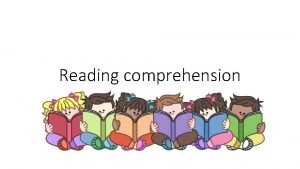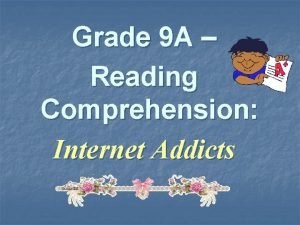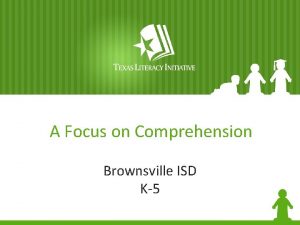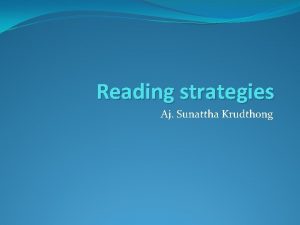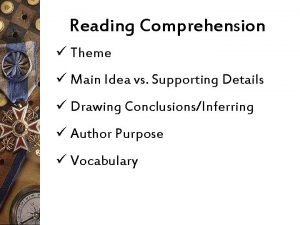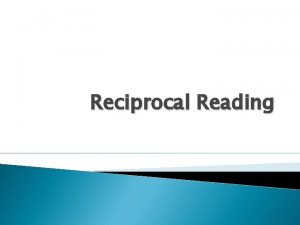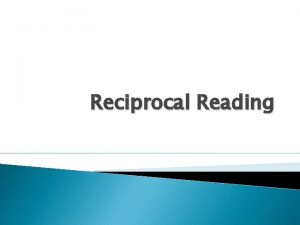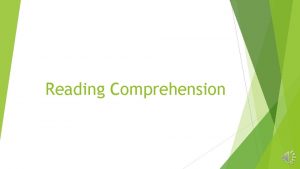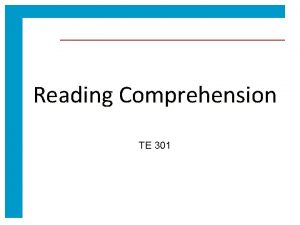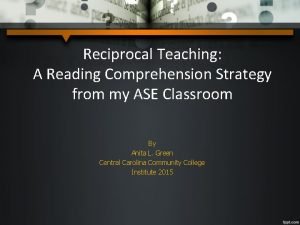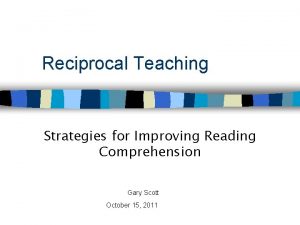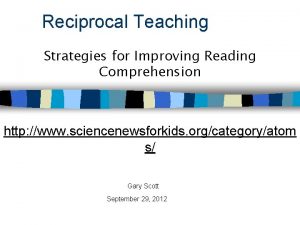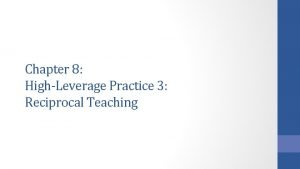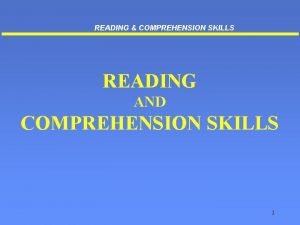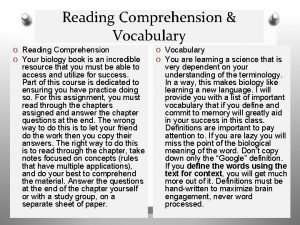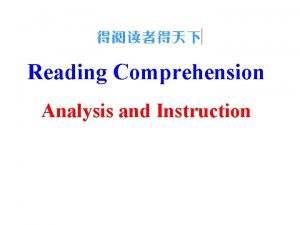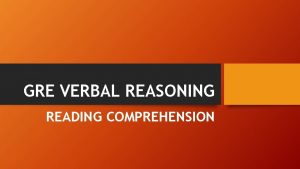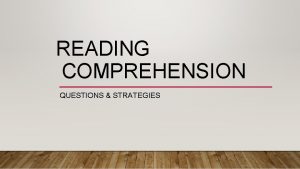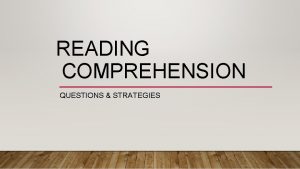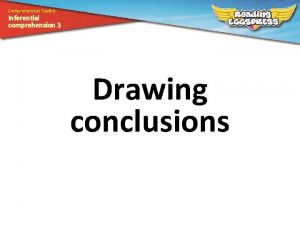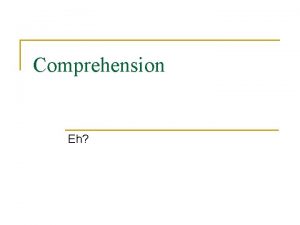The Effect of Reciprocal Teaching on Reading Comprehension











































- Slides: 43

The Effect of Reciprocal Teaching on Reading Comprehension of Iranian Intermediate EFL Learners By : Zohreh Saadati Zohre. saadati@yahoo. com

Background and Purpose

. �Palincsar and Brown (1984) �Alfassi (2004) �Bruer (1993)

Statement of the Problem �Reading comprehension is the heart and goal of reading �All students need to become strong readers and writers. �(Berninger & Shapiro, 2007)claimed that research in the area of prevention and intervention with reading comprehension has been sparse and needs to be expanded. �Palincsar and Brown (1984) emphasized that reciprocal teaching is designed to teach students cognitive strategies that might lead to improved reading comprehension.

Research Question �To fulfill the purpose of this study, the following research question was addressed: Does reciprocal teaching have any significant effect on reading comprehension of the intermediate EFL learners?

Research Hypothesis �In order to investigate the above-mentioned research question empirically, the following null hypothesis was stated: H 0: Reciprocal teaching does not have any significant effect on reading comprehension of the intermediate EFL learners.

Significance of the Study �Stevenson (1974) points out, few foreign students will have much occasion to speak and hear English after graduation, but they will have reason to read a professional journal or book in the foreign language. �King et al. (1975) assert that reading comprehension is the cornerstone skill from which listening comprehension as well as speaking and writing ability can best evolve. They also claim that for many students the desire to learn a foreign language is synonymous with the desire to read that language. �If reciprocal teaching has an effect on reading comprehension, it might be beneficial to students.

Definition of Key Terms �Reading Comprehension: As the process of simultaneously extracting and constructing meaning through interaction and involvement with written language (Snow, 2002, p. 11). �In this research, reading comprehension is opperationalized by a piloted PET reading comprehension test.

Definition of Key Terms �Reciprocal Teaching : is characterized as a dialogue taking place between the teacher and students (or student leader and members of the group) that results in students learning how to construct meaning when they are placed in must read situations (tests or assignments). The approach derives from theory that reading for meaning and retention—what is referred to as study reading—requires effort, a full repertoire of comprehension strategies (namely, summarizing, generating questions, clarifying and predicting), and the flexibility to use these strategies as the situation requires (Carolyn J. Carter and Diane F. Fekete, 2001, p. 23). �In this research, reciprocal teaching is approached via the framework provided by Carolyn J. Carter and Diane F. Fekete (2001).

Limitations of the Study 1. The researcher had two classes of 14 and 15 subjects in control group and two classes of 14 subjects in experimental group. 2. The researcher implemented reciprocal teaching only twelve sessions from sixteen instructional sessions; because she had to cover all other three skills based on the institute’s syllabus.

Delimitations of the Study Researcher implemented reciprocal teaching on intermediate students. Because it is assumed that elementary students are at the basic levels and can not follow the directions the same as intermediate students. Moreover, intermediate students are more manageable than elementary level students.

. Method

Participants �Fifty Seven intermediate female students participate in the study.

Instrumentation �Language proficiency test which is called preliminary English test or PET. �One pre-test of reading comprehension and one post-test of reading comprehension

Instrumentation �Books The book was Interchange (II) which is appropriate for intermediate level learners. Four units were covered during 16 sessions; the 17 th session was the exam session of students.

Procedure Based on the purpose of the study the researcher applied reciprocal teaching in twelve sessions and followed predetermined steps. : � First of all, the researcher sat aside one instructional day to introducing students each of the following comprehension strategies of reciprocal teaching including prediction, summarization, question generation and clarification in experimental group. � All instruction on how to develop and apply the four cognitive strategies took place during the dialogues. � After the teacher modeled strategy, the responsibility to perform the four strategies was given to student.

Design and Statistical Analysis �This study was a quasi-experimental one �Reciprocal teaching was the independent variable, reading comprehension the dependent variable, and gender and language proficiency as control variables. �t-test. �The reliability of the English proficiency test (PET) was estimated by utilizing Cronbach Alpha formula.

. Data Analysis and Result

Pre Test: Language Proficiency Test (PET) in Pilot Phase

Histogram of the Scores Obtained in the Language Proficiency Test in the Pilot Phase

Reliability of the Language Proficiency Test in the Pilot Phase

PET Used for Homogenizing the Subjects.

Independent Samples Test of Control & Experimental Groups

. Descriptive Statistics of the language Proficiency Test in the Study

Histogram of the Scores Obtained in the Language Proficiency Test in the Study

One-Sample Kolmogrove-Simirnove Test

Reliability of the Language Proficiency Test in the Study

Posttest: Reading Comprehension Descriptive Statistics of the posttest in the Pilot Phase Test in Pilot Phase

Histogram of the Scores Obtained in the Posttest of the Pilot Phase

Reliability of the Posttest in the Pilot Phase

Testing the Hypothesis Descriptive Statistics of the Control Group’s Scores in the Post Test

Histogram of the Control Group’s Scores in the Posttest

Descriptive Statistics of Experimental Group’s Scores in the posttest

Histogram of the Experimental Group’s Scores in the Posttest

Group Statistics of the Experimental and Control Groups

Independent Samples Test of the Experimental & Control Groups

. Conclusion

onclusion. C � Pearson and Dole (1987) stated that effective strategy instruction requires the teacher to who provides explicit explanation of strategies and scaffolding to help students construct understandings about the content of the text. Explicit teaching of strategies before reciprocal teaching appears to meet these requirements. � Palincsar and Brown (1984) claimed that the cycle of effective reading comprehension instruction begins with explicit strategy instruction by the teacher. For testing the presupposed null hypothesis, the researcher conducted an independent sample t-test between the control and experimental groups’ total scores of reading comprehension test. Since t-observed (2. 23) exceeded the critical value of t, 2. 00, at 55 degrees of freedom, it can be concluded that the experimental group out performed the control group.

Pedagogical Implications for Teaching and Teacher Training 1. Use of reciprocal teaching in language schools 2. By training teachers, successively students would benefit from this effective approach and teachers would have better learners in reading skill.

Implications for EFL Learners Training students reading comprehension strategies of reciprocal teaching including questioning, summarizing, clarifying, and predicting seems very advisable.

Implications for Material Designers In reading comprehension skill designing especial tasks based on reciprocal teaching reading comprehension strategies seems very advisable.

Suggestions for Further Research �It is suggested that similar studies could be conducted with other participants including male or male and female ones. �It is suggested that similar studies could be done with learners with higher or lower levels of language proficiency. �It is suggested that similar studies could be done with other methods in the other group such as applying guided reading in the second group. In other words, researchers could compare two reading interventions including reciprocal teaching and guided reading simultaneously.

. Thank you all
 While reading activities
While reading activities Reciprocal teaching definition
Reciprocal teaching definition Reciprocal reading role cards
Reciprocal reading role cards Reciprocal reading cards
Reciprocal reading cards Super six comprehension strategies nsw det
Super six comprehension strategies nsw det Cause and effect comprehension
Cause and effect comprehension Invention inspired by nature
Invention inspired by nature Story maps for reading comprehension
Story maps for reading comprehension My first job reading comprehension
My first job reading comprehension Reading comprehension jobs and professions
Reading comprehension jobs and professions Seven comprehension strategies
Seven comprehension strategies Reading comprehension meaning
Reading comprehension meaning Barriers of reading
Barriers of reading Yarc reading assessment
Yarc reading assessment Comprehension reading meaning
Comprehension reading meaning I was getting ready for sam's birthday
I was getting ready for sam's birthday If i were you i would
If i were you i would Comprehension for grade 9
Comprehension for grade 9 Rasul gamzatov ship
Rasul gamzatov ship Define reading comprehension
Define reading comprehension Super six
Super six Murder mystery reading comprehension
Murder mystery reading comprehension Vipers retrieve
Vipers retrieve The paragraph preceding the passage most probably discusses
The paragraph preceding the passage most probably discusses Main idea jeopardy
Main idea jeopardy Reading comprehension part 1
Reading comprehension part 1 Making predictions practice
Making predictions practice Headsprout comprehension
Headsprout comprehension Barrett's taxonomy of reading comprehension
Barrett's taxonomy of reading comprehension What is perceptive reading
What is perceptive reading Reading skills pyramid
Reading skills pyramid Grade 11 and 12 english reading comprehension
Grade 11 and 12 english reading comprehension Sra corrective reading decoding placement test
Sra corrective reading decoding placement test Persuasive comprehension
Persuasive comprehension The lost kitten reading passage
The lost kitten reading passage Scanning reading benefits
Scanning reading benefits Reading comprehension scraping the sky answer key
Reading comprehension scraping the sky answer key Are you an internet addict reading comprehension answers
Are you an internet addict reading comprehension answers K5 reading comprehension
K5 reading comprehension Your adventure begins
Your adventure begins Reading comprehension the adventure begins
Reading comprehension the adventure begins What is think aloud strategy
What is think aloud strategy It is pointed out in the reading that opera ----.
It is pointed out in the reading that opera ----. Theme vs topic
Theme vs topic


